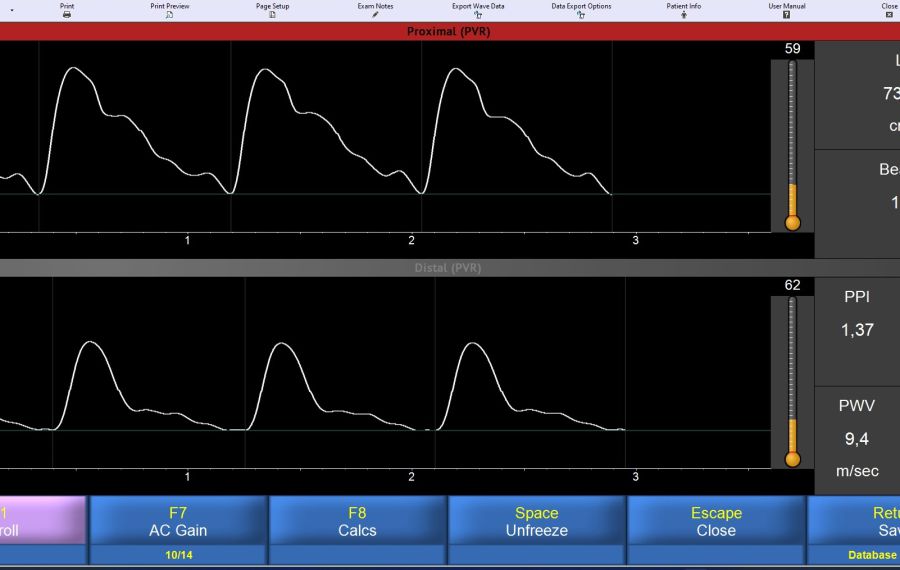Gold Standard Procedure
International scientific societies recommend the assessment of central aortic Pulse Wave Velocity (aPWV) [20, 21]. This is best done by recording of pulse waves from the carotid and femoral arteries. The resulting cfPWV is defined as the ratio of the distance between these two vessels and pulse wave transit time, the time, the pulse needs to travel from the carotid to the femoral site. cfPWV represents the undisputed Gold Standard in determining Arterial Stiffness [15], being directly related to Distensibility.
The easiest and most reliable modality to measure cfPWV is based on a simultaneous recording of oscillometric waves by use of plethysmographic cuffs. This method yields the lowest variability and is most comfortable for both operators and patients [5, 6]. An internationally acknowledged device operating according to this principle is Vicorder®.
Normative data for PWV have been published by the European Society of Hypertension [22]. This paper documents normal reference data related to degree of blood pressure and may be used in a clinical setting. As a rule of thumb and for a simple approach in evaluation of PWV - in a mid-age range and at a fairly normal blood pressure range – PWV can be categorized into:
Normal PWV < 10 m/s
Borderline 10 < PWV < 12 m/s
Pathological PWV > 12 m/s
Strongest Predictor of Cardio-Vascular Events
In a “Scientific Statement from the American Heart Association” [4] the importance of PWV as a clinical surrogate of Arterial Stiffness and an early indicator of atherosclerosis is described as follows:
PWV increases with increasing arterial stiffness and vascular damage. In adults, aortic PWV is strongly associated with the presence and extent of atherosclerosis and is increased in the presence of various cardiovascular risk factors, including diabetes, hypertension, end-stage renal disease, hyperlipidemia, increasing age, and sedentary lifestyle.
PWV is an important, perhaps even the strongest, independent predictor of cardiovascular events.
Other publications emphasize the extraordinary significance of PWV in evaluating cardio-vascular complications in different diseases, such as chronic kidney disease, diabetes, and hypertension.
With a mounting prevalence of hypertension, The European Societies of Cardiology and Hypertension and other scientific bodies issued recommendations for hypertension management, postulating PWV testing in clinical practice [21]. In comparison to traditional scores, PWV offers a much better assessment of individual patient risk [16]. A PWV increase can also be associated with enhanced vascular ageing, induced by an inadequate life style, mostly related to inactivity and obesity. Implemented into routine clinical practice, patients will profit from PWV testing by better risk stratification and therapy management.
Substandard PWV Methods
Some oscillometric blood pressure devices, mostly based on automated standard sphygmomanometers, offer a one channel estimation of PWV through an upper arm cuff only - without the recording of a second pressure wave. These devices claim to “measure” PWV using non-published, proprietary algorithms evaluating brachial pulse wave oscillations dependent on reflections, leading to reflection times, not pulse wave transit times. At best, these methods will allow an indirect estimation of PWV, as neither reflection points can be localized, nor can dependence on reflection properties unrelated to arterial distensibility be excluded. In particular, when the potential travel distance of the pulse wave is not measured from the trunk but estimated from body height, this indirect PWV approximation should not be called a “measurement”. Several studies have shown substantial differences between reflection dependent PWV estimation and Gold Standard cfPWV. In one instrument, deviations of more than +3.5 m/s were documented leading to the conclusion that results cannot be exchanged with those obtained by other devices [19]. As these one-channel-devices mostly offer differing PWV scales and bias, published PWV norms relating to cfPWV can hardly be applied.
Validation Guidelines
Guidelines for the validation of PWV [23] make it fairly easy to check the type and quality of PWV assessment in an instrument by searching for literature that confirms compliance of the given device with the guidelines.

